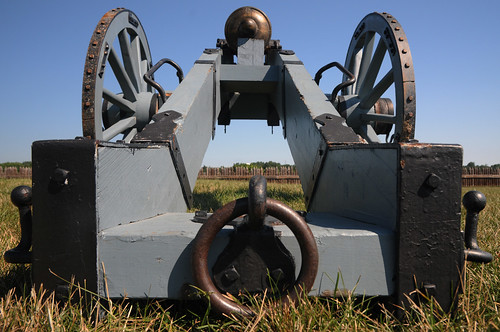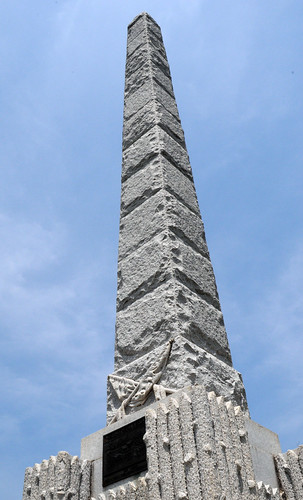This is Part II of a five-part series documenting the travels of Kentucky Guard Command Historian, John Trowbridge as he explores Kentucky's participation in the War of 1812.
Story and photos by Sgt. David Bolton, Kentucky National Guard Public Affairs Office
[caption id="" align="aligncenter" width="500"]

One of two cannons located inside the confines of Fort Meigs in Perrysburg, OH that were used as anti-enemy artillery for the Americans during the War of 1812. (Photo by: Sgt. David Bolton, Public Affairs Specialist, 133rd Mobile Public Affairs Detachment, Kentucky Army National Guard).
PERRYSBURG, Ohio-- Retracing the trail of the Kentucky militamen and their travels north to Canada and the surrounding areas during the War of 1812, has been of particular importance to Kentucky National Guard Command Historian John Trowbridge.
To see more photos from this story, click here
“I want to give that sense of chronological order to what the Kentuckians did,” said Trowbridge. “It was not a single campaign, it was a series of campaigns.”
All over northwestern Ohio, from Defiance, to the resupply point for troops at Fort Amanda in Lima, to Fort Meigs in Perrysburg where Dudley’s Defeat took place, many Kentucky militiamen fought and died. Kentucky militia also fought at sea during the Battle of Lake Erie at Catawba Island at Put-In-Bay for control of the main waterways to Canada.
“We had the highest number of casualties, nearly 64 percent of Americans killed were Kentuckians,” said Trowbridge.
[caption id="" align="alignright" width="303"]

An obelisk stands as a monument to mark the area where Fort Amanda once stood in Lima, Ohio July 7, 2012. The fort was occupied by Kentucky militiamen and served as a rally point for troops heading north to defend Detroit during the War of 1812. (Photo by: Sgt. David Bolton, Public Affairs Specialist, 133rd Mobile Public Affairs Detachment, Kentucky Army National Guard).
Trowbridge attributes the high number of Kentucky losses to a combination of factors.
He said these high percentages of fatalities showed the patriotism of the Soldiers from Kentucky but, also, the poor discipline and poor leadership they had.
But what made Ohio such a hotspot for battles? Ohio was, geographically, a straight shot to Detroit. The goal for the Kentucky militia, led by Gen. William Henry Harrison, was to retake Detroit and use it as a stepping-stone to enter into Canada.
According to Trowbridge, during the War of 1812 Kentucky provided the manpower to fight in the old northwest territories by furnishing a total of 40 regiments of volunteer militia, as well as a number of battalions and separate companies totaling more than 25,000 men.
At the time, other states were debating on the purpose of the militia and the boundaries that they would maintain. Some interpreted the role of the state militias to operate solely within the confines of the state. Others approved the use of the militias outside the boundaries of the state however, they would not allow them to go across international borders.
“Kentucky had no qualms with doing that,” said Trowbridge. “Kentucky was there to answer the call and got the approval to cross the boundaries of our Commonwealth as well as go into Canada. They answered the federal call, the same as they do today.”